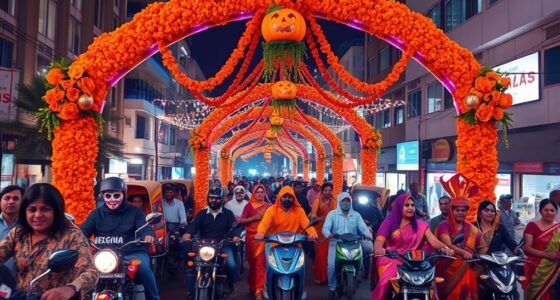Phi Ta Khon, Thailand’s vibrant ghost festival, celebrates spirits and ancestors through lively parades, colorful masks, and costumes crafted from paper, cloth, and wood. You’ll see dance performances, music, and playful pranks that honor tradition while mixing humor and satire. Participants wear elaborate masks representing demons and mythical creatures, creating a festive and energetic atmosphere. If you want to explore how this spirited event blends cultural, religious, and community elements, there’s more to discover beyond the surface.
Key Takeaways
- Phi Ta Khon is a vibrant Thai festival celebrating spirits, ancestors, and local folklore through colorful masks and costumes.
- Participants wear elaborate masks and costumes, depicting ghosts, demons, and mythical creatures, transforming streets into lively parades.
- The festival combines religious ceremonies, dance, music, humor, and playful pranks, emphasizing community bonding and cultural pride.
- Originating from ancient legends and Buddhist influences, it honors spirits for good harvests and ancestral roots.
- The event features street festivities, traditional rituals, and satire, creating a lively atmosphere blending reverence and entertainment.

Every year, during the vibrant Phi Ta Khon festival in Thailand, locals transform into lively ghosts and spirits to celebrate tradition and folklore. This lively event, held in the Dan Sai district of Loei Province, is rooted in mythical origins that blend local legends with Buddhist influences. You’ll find that the festival’s history is rich with stories about spirits and ancestors, which have been passed down through generations. The origins are believed to trace back centuries, where villagers honored spirits to ensure good harvests and protection from evil. Over time, these stories evolved into the unique festival traditions that you see today, combining religious reverence with exuberant celebration.
During the festival, you’ll notice that participants wear elaborate masks and costumes, often made from paper, cloth, and wood, designed to resemble ghosts, demons, and mythical creatures. These masks are the centerpiece of the event, transforming the streets into a vibrant parade of color and creativity. The festival traditions also include lively dance performances, music, and playful pranks, which serve to entertain and ward off evil spirits. You might see locals and visitors alike joining in the processions, throwing confetti, or engaging in humorous antics that symbolize the spirits’ playful nature. The costumes and masks are not just for show—they’re believed to embody the spirits’ lively energy, connecting the community to its ancestral roots. Additionally, the festival’s emphasis on humor and satire fosters a sense of community and cultural pride.
The celebrations typically begin with a religious ceremony in local temples, where monks bless the masks and participants. Afterward, the festivities spill into the streets, with participants dancing, singing, and performing traditional rituals. The festival tradition emphasizes humor and satire, often poking fun at authority figures or local customs, which adds a layer of lightheartedness to the event. As you walk through the lively streets, you’ll feel the sense of unity and joy that these traditions foster, as everyone participates in honoring spirits through colorful displays and communal activities. Cultural significance plays a crucial role in maintaining the festival’s lively and meaningful atmosphere.
Frequently Asked Questions
How Long Does the Phi Ta Khon Festival Typically Last?
You might wonder about the festival duration and its cultural significance. Typically, the Phi Ta Khon festival lasts about three days, usually during the third weekend of June. This vibrant event holds great cultural importance as it celebrates local legends, spirits, and community spirit. During this time, people wear colorful masks and costumes, making the festival a lively, meaningful tradition that strengthens local identity and preserves ancient customs.
What Are the Origins of the Ghost Masks Used in the Festival?
Imagine masks as windows into spirits. The ghost masks in the festival symbolize ancestral spirits and local legends, embodying mask symbolism with deep spiritual significance. You’d find they originate from traditional beliefs and rituals, crafted to ward off evil spirits and honor ancestors. These vibrant masks serve as a bridge between the living and the spiritual world, making them powerful tools in honoring tradition and maintaining cultural harmony.
Are There Specific Rituals Performed During Phi Ta Khon?
During the festival, you’ll witness specific rituals like traditional dance performances that honor spirits and celebrate community. The masks, with their vibrant colors and exaggerated features, symbolize spirits and ancestors, playing a key role in these ceremonies. As you participate, you’ll see how mask symbolism and lively dances come together, creating a spirited and meaningful experience that reconnects locals with their history and cultural beliefs.
How Has the Festival Evolved Over the Years?
You’ve probably seen how festivals evolve, transforming dramatically over time. Today, this festival’s cultural significance remains strong, but it’s also experienced some festival modernization. Traditional masks and dances now blend with contemporary elements, making it more vibrant and accessible. While the core spirit endures, the way people celebrate has adapted, reflecting changing values and creativity. You’ll find a dynamic mix of tradition and innovation that keeps the festival fresh and exciting.
Is Phi Ta Khon Celebrated Outside of Dan Sai Village?
You might wonder if Phi Ta Khon is celebrated outside Dan Sai village. Due to travel restrictions, celebrations outside the village are rare, and the festival’s cultural authenticity remains strongest in its original setting. While some nearby areas may host smaller events, the true spirit and traditional rituals are best experienced in Dan Sai. This helps preserve the festival’s unique cultural significance and keeps its authentic roots intact.
Conclusion
As you immerse yourself in the vibrant chaos of Phi Ta Khon, you realize it’s more than just a festival—it’s a glimpse into Thailand’s deepest traditions and beliefs. But as the masks are removed and the crowds disperse, you can’t help but wonder what stories remain hidden beneath those colorful faces. Will you uncover the mysteries behind the masks, or will some secrets stay buried in the shadows, waiting for the next ghostly dance to reveal themselves?










